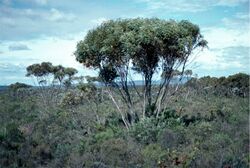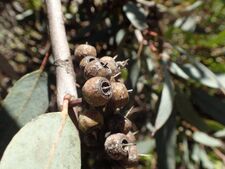Biology:Eucalyptus falcata
| Silver mallet | |
|---|---|

| |
| Eucalyptus falcata in the Fitzgerald River National Park | |
| Scientific classification | |
| Kingdom: | Plantae |
| Clade: | Tracheophytes |
| Clade: | Angiosperms |
| Clade: | Eudicots |
| Clade: | Rosids |
| Order: | Myrtales |
| Family: | Myrtaceae |
| Genus: | Eucalyptus |
| Species: | E. falcata
|
| Binomial name | |
| Eucalyptus falcata Turcz.[1]
| |
| Synonyms[1] | |
| |
Eucalyptus falcata, commonly known as silver mallet[2] or toolyumuck,[3] is a species of mallee or marlock that is endemic to Western Australia. It has smooth bark, lance-shaped to curved adult leaves, flower buds in groups of eleven or thirteen, creamy white or yellowish green flowers and flattened spherical fruit.
Description
Eucalyptus falcata is a mallee or marlock that forms a lignotuber and typically grows to a height of 5–6 m (16–20 ft). It has smooth, silvery gray and green-gray over pale brown-orange bark. Young plants and coppice regrowth have egg-shaped, petiolate leaves arranged in opposite pairs and 35–60 mm (1.4–2.4 in) long and 20–30 mm (0.79–1.18 in) wide. Adult leaves are arranged alternately, the same shade of green on both sides, lance-shaped to curved, 55–130 mm (2.2–5.1 in) long and 10–20 mm (0.39–0.79 in) wide on a petiole 10–27 mm (0.39–1.06 in) long. The flower buds are arranged in leaf axils in groups of eleven or thirteen on an unbranched, down-turned peduncle 7–22 mm (0.28–0.87 in) long, the individual buds on pedicels 1–7 mm (0.039–0.276 in) long. Mature buds are oval, 10–19 mm (0.39–0.75 in) long and 5–8 mm (0.20–0.31 in) wide with an elongated, conical operculum. Flowering occurs between August and May and the flowers are creamy white or yellowish green. The fruit is a woody, flattened spherical capsule 4–9 mm (0.16–0.35 in) long and 8–11 mm (0.31–0.43 in) wide on a pedicel up to 8 mm (0.31 in) long.[2][4]
This species is closely related to E. ornata and E. recta, as well as the recently described E. rugulata and E. purpurata.[5]
Taxonomy and naming
Eucalyptus falcata was first formally described in 1847 by Nikolai Turczaninow in Bulletin de la Société Impériale des Naturalistes de Moscou from a specimen collected by James Drummond.[6][7] The specific epithet (falcata) is a Latin word meaning "sickle-shaped".[8]
Noongar peoples know the tree as toolyumuck.[3]
Distribution and habitat
Silver mallet has a scattered distribution of isolated populations from near Kojonup, to near Corrigin and north to Tammin, in the Avon Wheatbelt, Esperance Plains, Geraldton Sandplains, Jarrah Forest, Mallee, Swan Coastal Plain and Warren biogeographic regions. It is often found on the top or slopes of lateritic rises and is associated with species such as E. astringens, E. densa, E. incrassata, E. salmonophloia, E. urna and E. wandoo.[5]
Conservation status
This eucalypt is classified as "not threatened" by the Western Australian Government Department of Parks and Wildlife.[2]
See also
References
- ↑ 1.0 1.1 "Eucalyptus falcata". Australian Plant Census. https://biodiversity.org.au/nsl/services/apc-format/display/80928.
- ↑ 2.0 2.1 2.2 "Eucalyptus falcata". FloraBase. Western Australian Government Department of Parks and Wildlife. https://florabase.dpaw.wa.gov.au/browse/profile/5643.
- ↑ 3.0 3.1 "Noongar names for plants". kippleonline.net. http://www.kippleonline.net/bobhoward/plantsframe.html.
- ↑ "Eucalyptus falcata". Centre for Australian National Biodiversity Research. https://apps.lucidcentral.org/euclid/text/entities/eucalyptus_falcata.htm.
- ↑ 5.0 5.1 "Eucalyptus falcata (silver mallet)". Eucalypts of Western Australia. http://www.eucalyptsofwa.com.au/E.%20falcata.%20EucalyptsOfWheatbelt_falcata.pdf.
- ↑ "Eucalyptus falcata". APNI. https://id.biodiversity.org.au/instance/apni/455231.
- ↑ Turczaninow, Nikolai (1847). "Decas tertia generum adhuc non descriptorum, adjectis descriptionibus nonnullarum specierum Myrtacearum xerocarpicarum atque Umbelliferarum imperfectarum.". Bulletin de la Société Impériale des Naturalistes de Moscou 20 (1): 163. https://www.biodiversitylibrary.org/item/107031#page/169/mode/1up. Retrieved 5 July 2019.
- ↑ Brown, Roland Wilbur (1956). The Composition of Scientific Words. Washington, D.C.: Smithsonian Institution Press. p. 710.
Wikidata ☰ Q15396167 entry
 |



